Joe the prepper is making some headway. He’d found a couple of gun stores in his town that were patient with his learning curve and welcoming of his questions. So far he’d bought a Glock in .40 SW, a .357/.38 spl. revolver, and a smallish semi auto in .22 LR. He felt pretty good about the progress he was making with his preps regarding defense of the family. He was also pleased and a little proud of himself for all the new information that he’d been processing. Nevertheless, with all Joe had learned, he knew that in a worst-worst-worst case scenario he’d need more than a brace of handguns to have the best chance of successfully defending his family. To maximize his opportunities he knew he was going to have to get a long gun. Or two.
While Joe lives smack dab in a subdivision, he likes to say he lives “on the edge of suburbia”. Not a half mile down the main road, the “burbs give way to small farms and open spaces and grazing cattle and horses. In spite of that, Joe also is well aware that two miles the other way down the main road is the freeway, and ten miles down the freeway puts one in the inner city. “Not even much of a full day’s walk”, Joe reminded himself frequently, as he worked to understand exactly what a worst-case scenario could be like for him and his family. He also knew that the county jail and a minimum security prison were within that same ten mile radius. The realization illicited a prickling up Joe’s neck when he thought about it.
And so it was back to the drawing board for Joe. He hit YouTube and a few trusted firearms related sites, and spent most of Saturday at his two favorite gun stores. This is most of what he learned:
1. Shotguns
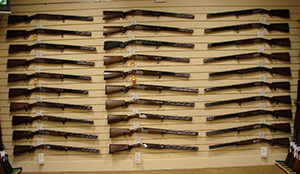 At close range a 12 gauge shotgun is a formidable weapon when loaded with either 00 Buckshot (double-aught), or slugs. Shotguns in smaller chamberings can be fun and effective for harvesting game, but 12 gauge is a superior defensive chambering, and it will likely be quite forage-ble/barter-able in an extended WROL scenario. A 12 gauge shotgun can also be “downloaded” with #7 shot for taking fowl and other small game in the field. A shotgun, depending on whether and/or how the barrel is choked, is effective out to 50 to 100 yards, so it is limited in range. Most pump action (slide action), and semi auto shotguns have an “underbarrel” magazine with a capacity from 4 to 8 rounds usually, so to find a good way to carry extra shells is a must. Most shotguns are fitted with a simple “bead style” front sight-this is most common with bird hunting guns. Nowadays, there are many manufacturers that eschew the bead sight, and use rifle type sights for their defensive shotgun offerings. Additionally, many weapons can be retrofitted with upgraded sights.
At close range a 12 gauge shotgun is a formidable weapon when loaded with either 00 Buckshot (double-aught), or slugs. Shotguns in smaller chamberings can be fun and effective for harvesting game, but 12 gauge is a superior defensive chambering, and it will likely be quite forage-ble/barter-able in an extended WROL scenario. A 12 gauge shotgun can also be “downloaded” with #7 shot for taking fowl and other small game in the field. A shotgun, depending on whether and/or how the barrel is choked, is effective out to 50 to 100 yards, so it is limited in range. Most pump action (slide action), and semi auto shotguns have an “underbarrel” magazine with a capacity from 4 to 8 rounds usually, so to find a good way to carry extra shells is a must. Most shotguns are fitted with a simple “bead style” front sight-this is most common with bird hunting guns. Nowadays, there are many manufacturers that eschew the bead sight, and use rifle type sights for their defensive shotgun offerings. Additionally, many weapons can be retrofitted with upgraded sights.
A shorter barrel is preferable for defensive situations as it is more portable and is more difficult to wrest from one in tight quarters. The legal limit for shotgun barrels is a federally mandated 18.5 inches. Longer barrels are better suited for hunting. Some makers offer packages that include interchangeable hunting and defense barrels. A sling on a shotgun is as necessary as it is on a rifle. After handling more than a dozen shotguns, Joe concluded that the readily identifiable “chuk-chuk” of the slide of a shotgun being racked back and forth was pretty much a universal statement to the effect “your day is fixin’ to get a whole lot worse”. So he opted for the pump action shotgun.
2. Bolt Action and Lever Action Rifles
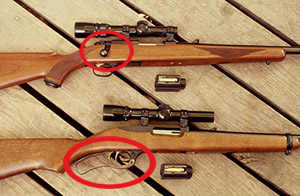 Bolt action and lever action weapons have their respective roles, but may be a liability in some cases due to the fact that reloading either is slow compared to changing magazines in a semi auto rifle.
Bolt action and lever action weapons have their respective roles, but may be a liability in some cases due to the fact that reloading either is slow compared to changing magazines in a semi auto rifle.
By their nature, bolt action rifles are typically more accurate than semi auto rifles, simply due to less moving parts. There are some exceptions of course, but an $800 bolt action is quite likely to be much more accurate than an $800 AR variant. Bolt actions can be had in a much wider array of much more powerful calibers also than one can usually find in typical defensive rifles. The defensive niche the bolt action fills then, is that of hunter, and also if one is properly ensconsed and covered, the bolt action can well defend one’s life and property at much greater ranges than a typical defensive rifle. Of course the trade off is the speed of reloading the weapon. Also, the barrel length of most bolt actions make them prohibitive in a close-quarter (like inside your house) defensive situation. In many ways a quality bolt action is a must because of its range and ability to harvest game, but as a main line defensive platform it lacks in some areas.
Lever actions (cowbow rifles), however, are just plain cool. In the right hands a lever action can serve as a formidable weapon in a short range situation, but again they lack the speed-reloading ability of a magazine fed weapon. In any situation where a handgun is a good bet, a lever action rifle is probably a better bet. Lever actions can be found chambered in everything from .22 LR up through the revolver cartridges like .357 and .44, through the old blackpowder cartridges like the venerable .30-.30 and beyond. But again, the time to reload the weapon seemed clearly far too long. Especially under duress. Like taking live fire.
3. Semi Automatic Rifles
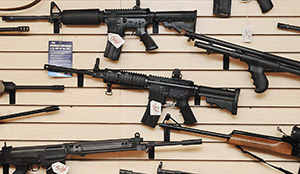 Semi auto variants of common military weapons are various in complexity, type of action (how the weapon cycles when a round is fired to eject the spent case and to load the next round), calibers even, and of course price. In the main there are two types of semi auto defensive weapons regarding the type of action. There are “direct impingement” weapons like the the esteemed M16/M4, where the gases actually cycle the bolt. Then, there are “piston operated” weapons wherein the gases cycle the piston, and the reciprocation of the piston cycles the action of the weapon. In short, direct impingement weapons run “hotter” as the gases are in direct contact with the rifle’s action. Generally speaking, however, they have fewer parts and the parts are more universal (interchangeable) from weapon to weapon-including magazines.
Semi auto variants of common military weapons are various in complexity, type of action (how the weapon cycles when a round is fired to eject the spent case and to load the next round), calibers even, and of course price. In the main there are two types of semi auto defensive weapons regarding the type of action. There are “direct impingement” weapons like the the esteemed M16/M4, where the gases actually cycle the bolt. Then, there are “piston operated” weapons wherein the gases cycle the piston, and the reciprocation of the piston cycles the action of the weapon. In short, direct impingement weapons run “hotter” as the gases are in direct contact with the rifle’s action. Generally speaking, however, they have fewer parts and the parts are more universal (interchangeable) from weapon to weapon-including magazines.
Piston driven rifles on the other hand run a little cooler and cycle a little more smoothly than direct impingement weapons. Also, most of the key parts of the action are proprietary from brand to brand so there is little if any opportunity scavenge parts-including and especially magazines in a grid down scenario. AR’s are direct impingement guns. Including the semi auto variants of the venerable AK-47, there are a host of piston driven weapons on the market, including the FAL pattern rifles and the SCARS, and a host of AR looking piston operated weapons.
The most lucid advice Joe felt he got that Saturday came from Jim at Jim’s guns:
“Joe, if you’re just building a defensive battery and you are thinking of an AR style weapon, stick to the direct impingement guns for now. The parts are interchangeable, and if shtf, scavenge-able parts will be abundant. If you buy a piston gun for your first AR and the world goes to heck, you may or may not ever be able to find/scavenge/salvage parts for the weapon. If you already have a solid battery in place and then you want a little different shooting experience then think about buying a piston weapon. Or two.”
Other things Joe learned-generally speaking – the AR’s are more accurate than AK’s. The AK’s are highly touted for their reliability in adverse conditions. The 5.56 round that was developed from the Remington .223 is a marginal all around cartridge for sure, but it does allow one to pack more ammo. The 7.62×39 cartridge the AK is commonly chambered in is effective out to about 300 yards. Neither cartridge holds a candle to the .308 Winchester, but the .308 is larger and heavier (and more expensive) so its a little harder for the average guy to pack around the same round count as he could for a 5.56 weapon. There are other chamberings for the AR, but many of them are not entirely abundant, and so the possiblity of scavenging rounds for weapons chambered in these will be difficult if hard times do come.
The other cartridge that AK’s are frequently (though not as frequently as the 7.62×39), is the 5.45×39. The AK variants chambered in 5.45×39 are called AK-74’s. The 5.45×39 round was developed by the Soviets about twenty years after the 5.56 cartridge was developed by the US. It is ballistically superior and is a better manstopper than the 5.56. The down side-magazines and ammo are a little harder to find. The AK 74 was designed to be both more accurate and more reliable than the AK 47. And Jim leaned across the counter and almost whispered when he told Joe
“And I understand most of the Russian forces and the Spetznas are issued the ’74 nowdays.”
The comment sparked Joe’s imagination a bit. Joe also learned about the importance of cold hammer forged barrels in terms of barrel longevity.
4. Utility vs Portability
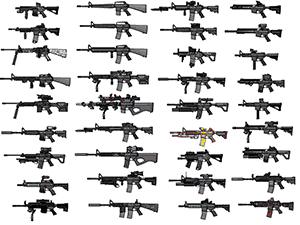 The AR platform is remarkably versatile and a quality weapon can serve as a sniper (out to 500-600 yards) weapon, or as a close quarters weapon and just about everything in between. And so, there is all kinds of accessories available to both customize the weapon, and also to “tune” the weapon for a specific tasking. The challenge is to maximize the utility of the weapon without overgearing it. A principle advantage of an AR type weapon is the portability. This advantage can be greatly diminished by adding 3 or 4 pounds of gear. That means one must be mindful and judicious in choosing add-ons. A weapon with a scope and a bipod is obviously set up for longer range accuracy. A weapon with a foregrip, flashlight, and laser sight is set up more for close quarters defense. A weapon with all the forementioned accessories will be heavy enough and awkward enough to be a bit cumbersome in both those roles and so ends up not doing either especially well.
The AR platform is remarkably versatile and a quality weapon can serve as a sniper (out to 500-600 yards) weapon, or as a close quarters weapon and just about everything in between. And so, there is all kinds of accessories available to both customize the weapon, and also to “tune” the weapon for a specific tasking. The challenge is to maximize the utility of the weapon without overgearing it. A principle advantage of an AR type weapon is the portability. This advantage can be greatly diminished by adding 3 or 4 pounds of gear. That means one must be mindful and judicious in choosing add-ons. A weapon with a scope and a bipod is obviously set up for longer range accuracy. A weapon with a foregrip, flashlight, and laser sight is set up more for close quarters defense. A weapon with all the forementioned accessories will be heavy enough and awkward enough to be a bit cumbersome in both those roles and so ends up not doing either especially well.
Herein lies the advantage of picatinny rails and quad rail handguards. These allow for the weapon to be outfitted quickly for a specific purpose. The downside is the quad rails are heavier than the stock handguards, and there is an abundance of rough edges. Therefore, if one foresees needing defensive flexibility, then the quadrail is helpful. If one has a good, long range platform like a bolt action already outfitted with a scope and bipod, then one can focus on close quarters type defensive applications for one’s AR (or AK or other semi auto defensive rifle for that matter), then one may be well advised to stick with the stock handguards to maximize the portability of the weapon. To this point Jim shared anecdotally that he’d known veterans that had gone into combat with all the latest and greatest mounted on their AR and in two or three days time they had ditched much of the gear due to excessive weight and because it diminished the portability of the weapon. Jim then searched “gun geardo” on his web browser and showed Joe the pictures. Joe got the point very quickly. While many of the photos were obviously satire, other pictures showed exactly what Jim was talking about. Joe decided decidedly that HE was not going to be a geardo.
In light of all that he’d learned by the end of the day Joe was pretty sure he was going to get an AR chambered in 5.56 manufactured by an outfit in Georgia that used cold hammer forged barrels and was run by an ex military operator guy of some sort. The guns are made to be durable, and include what you need and avoid what you don’t. He wanted the model with the ventilated handguard because it was the lightest one of the bunch, and was pulling out his wallet when the thought occurred to him -“one is none and two is one”. He put the wallet back and pulled out his cell phone. Mamma concurred with his reasoning. Folding the phone and putting it back in his pocket Joe said to Jim: “Actually, I’ll take two of them”. “Good thinking,” Jim replied and nodded approvingly.
That day Joe also got an AR front sight tool, an AR tool that is useful for things like castle nuts on AR’s, a pair of single point slings with quick detach pieces that fit tidily and securely into a recess the manufacturer had thoughtfully put in the rear of the receiver, more gun oil and cleaning solvent, and a handful of mags. Joe knew he’d need more than the handful, but next payday he hoped to acquire more mags and sufficient ammo for the weapons.
At home Joe took the weapons out of their boxes and looked at them. “Man, I hope I never, ever have to use these,” Joe thought with a bit of a grimace. Hopefully Joe won’t ever have to use the weapons for anything more than a little range time. But, its nice for Joe -and his wife and children- that the weapons are there in the event they some day are necessary.
You may also like:
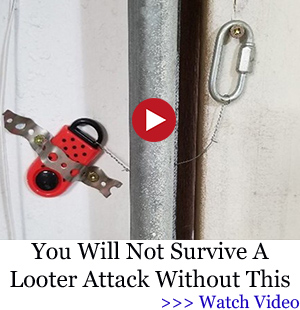 Firearm Tips for New Preppers and/or Those Who are New to Firearms
Firearm Tips for New Preppers and/or Those Who are New to Firearms
If You are too Weak to Prep than You Need to Watch This Video (Video)
Building an Attic Sniper’s Nest
How Long Can You Store Water Before It Becomes Unsafe To Drink?















Excellent info.
All great tips. Thank you!
Your data on shotgun barrel length is incorrect. 18in is the minimum length for a shotgun barrel and tip to tail the gun must be 26in. Its in section 2.1.2 of the NFA.
…of course thats just if you dont want to register and pay the $200 tax. Then you can get it quite a bit shorter.
18.5 is used so that just in case you measured 1/32 of an inch short, you don’t accidentally wind up in court sitting at the defense side of the table. The xtra 1/2 inch isn’t that big a deal in real life, but 1/32 of an inch could get you in real hot water. Why risk having to spend $50K or more when a little xtra length eliminates that possibility?
18.5″ is required by Canada for both shotguns and for rifles.. and 26″ overall, in fire-able configuration.
Less than this constitutes a change in classification.. from “Unrestricted” to “Restricted”.
Contrary to what many believe, not all pistols/revolvers are PROHIBITED classification… but basically 25 and 32 calibers are considered “Saturday Night Specials” and are Prohibited. Period… as are any handgun with a barrel under 105mm (about 4-3/32″).. If the handgun has longer barrel than this it is “restricted class”, and transporting across Canada takes special permission, to be granted in advance of your trip thru Canada Firearms Centre.
There are details.. if you need, check it out before attempting to take any firearm thru Canada. Unrestricted can be carried without hassle but you will need to fill out a form (used to be a 909).. and pay a $25 (Canadian)fee.
This is a post I put on the thread related to EMP, but in the bottom part I make mention.. suggestions and why.. I think would be a good bases for arms selection. I did not suggest the AR15 but it would DEFINATELY be my first choice, first because it is VERY common and pretty much standardized.. If your butt stock fails you can easily find a replacement.. even if it isn’t the same as the one that failed; it will work! Magazines are interchangeable as well..
If you have something else, great! Im just saying if you want to go buy something.. some food for thought.
Since all of you are fellow preppers I wanted to suggest some reading materials .. some of them are directly related to EMP.. and some have sections on EMP.. some are homesteading/off grid info.. but they are some of the best Iv come across. This is very limited.. many of my own are to do with cold weather survival as I live in the “northern most frontier”..
As Iv mentioned earlier, Im an Extra Class ham with decades of experience with radio waves and radio electronics.. not that I know it all but I do have extensive understanding of radio waves.. and EMP is basically a radio wave.
One of my books that might be helpful (especially for engineers).. is “EMP protection for emergency operating centers” United States, Defense Civil Preparedness Agency.
Another book I HIGHLY recommend has to do with nuclear war survival. Many people say they want to be at ground zero and not survive a nuclear war.. trouble with that is if you are not. Sticking your head in the sand will not only not make it go away.. but the relatively simple procedures that would save you.. you wont know so you will suffer the very death you fear most.
I would suggest checking out KI4U website.. I also suggest getting a copy of “Life Saving Nuclear Facts and Self-Help Instructions.. NUCLEAR WAR SURVIVAL SKILLS”.. by Cresson H. Kearny.
What people do not know.. the worst of radiation deteriorates rather quickly.. This book can be downloaded free at https://www.oism.org/nwss/ I would recommend BUYING the book on Amazon.. but you can certainly review it online. It covers a great deal.
Another book I suggest.. not that Im a Mormon but they are the MASTERS at prepping. But that would be THEIR own prepping book.. I will have to look it up.. I have copies of it in 2011 and 2013 or so.. Much the same.. but they offer a great deal.
Planning and building designs.. “The New Pioneer’s Handbook”.. they approach everything scientifically… calculating calories of food for what you will need per person/per day sort of thing.. They also show you how to calculate your energy losses for your home.. how to calculate heater size for a cabin.. that sort of thing. Iv absorbed much of it but haven’t memorized all these things..
Cheese making.. if you like cheese’s.. is Rickki Carrolls “Home Cheese Making”..
Please folks, I do not get a single penny for recommending these books.. I gain ONLY that others are more prepared, survive.. I believe the better people are prepared.. the less people will be trying to burn me out to steal what I have.. and the better we are as a nation, to rebuild.
A VERY good book to read .. to get a much clearer concept of how things might be if we should have an EMP that is anywhere near as bad as many think it would be.. is “One Second After”. It tells in story form, of the things that might well happen.. and the things that follow.. The story is fictitious .. but the places are not.. and the sequence of events are not just possible.. but probable. Its a good read as well..
Another good read is “The Patriot”. its written by James Rawls, the guy at the helm of “survivalblog.com”, one of my highly esteemed sites.
One of the things I strongly encourage.. (I should put this under the guns section!).. is if you are choosing a weapon for TEOTWAWKI .. or any situation where you are defending your place..possibly as a group of people.. you want to have COMMON AMMUNITION… but not only common ammunition but common magazines at minimum. Imagine the chaos if you were in a war.. and everyone shot a different ammo?.. Or, you run out of ammo in a shoot out.. and I through you a magazine of the same ammo.. but different clip. YOU will have to unload the magazine and reload it into yours.. WHILE PEOPLE ARE SHOOTING AT YOU. Not a good idea.
Now I know this will be WAY out there for many of you.. but it COULD all happen! Personally, my concept is to have it and not need it .. then need it and NOT have it… cause then you die.. and your family.. and all the stuff you worked to be prepared for.. is now someone elses.
I have made the decision to go with 5.56mm (.223).. because the round is small, light.. and one can pack a good deal of ammo in a small space. Another reason.. many sources of ammo will dry up. Powder will be hard to find.. as will primers, projectiles.. This round is not only very common but its a military round as well and has a much better chance of being around for that reason.
308 would be a second choice, although it is larger, heavier and gear for it is heavier. For me in Alaska I would probably want at least something suitable for large game…In the lower 48, while 223 is not legal for big game in most states, a decent shot will drop a deer. if you are lucky enough to find under dire circumstances.
Books on identifying wild plants.. knowing those that are toxic/poisonous.. Mine will be different from yours!
Anyway, these are just some good backbone books I think you will find invaluable!
Best to ALL of you out there!
BTW, most law enforcement across Alaska uses 40sw. empty cases are NOT hard to find!
??
Robert Tofaeono